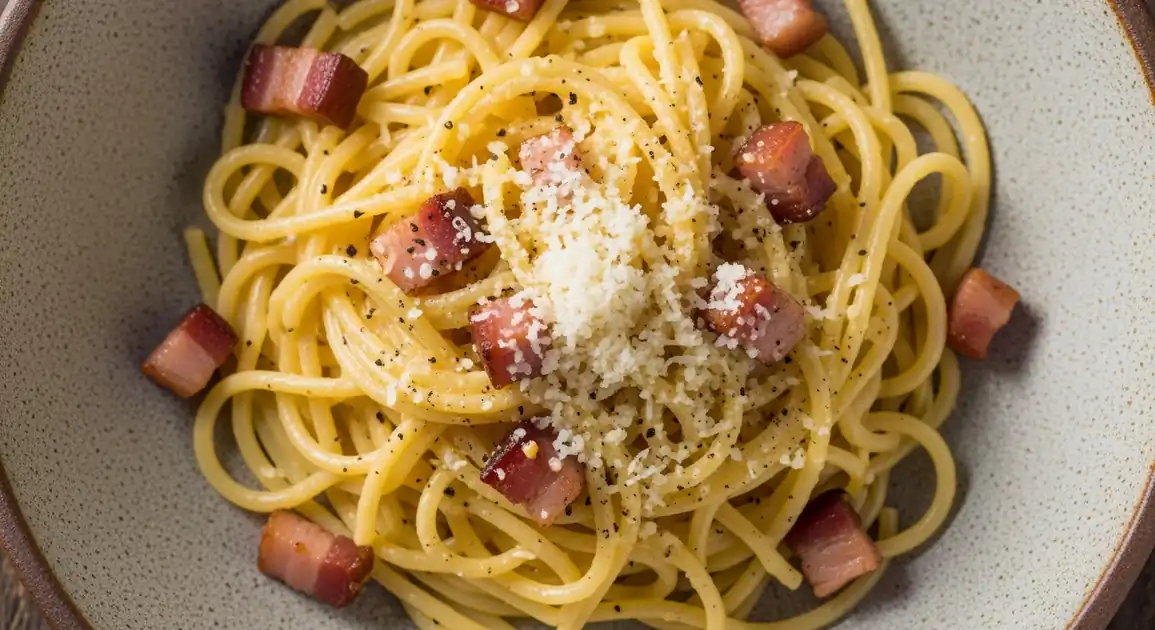Carbonara
Pasta alla Carbonara

Description
Rome is the birthplace and spiritual home of Carbonara. Here, the dish is prepared with almost religious adherence to tradition: guanciale (not bacon), Pecorino Romano (not Parmesan), eggs, and black pepper - never cream. Romans take immense pride in this relatively young but iconic dish, and the best versions are found in the city's traditional 'trattorie' and 'osterie', particularly in historically working-class neighborhoods.
Dietary Information
Serving information
Serving style
Served in wide, shallow bowls or plates as a 'primo piatto' (first course). Portion sizes are moderate, designed to be part of a full meal potentially including 'secondo' (main) and 'contorno' (side).
Quick facts
Lunch service typically 12:30 PM - 2:30 PM. Dinner service 7:30 PM - 10:30 PM. Many restaurants close between lunch and dinner.
Safety Tips
What to Look For
-
Reputable restaurants with good turnover of customers
Busy restaurants are more likely to have fresh ingredients and proper food handling practices.
-
Proper temperature - the dish should be served hot, immediately after preparation
This ensures the eggs have reached a safe temperature while creating the sauce, and prevents bacterial growth.
-
Silky, smooth sauce texture without visible bits of scrambled egg
Indicates proper technique where eggs have been gently cooked by the heat of the pasta without becoming fully scrambled.
-
Clean, well-maintained establishment with proper refrigeration
Suggests good handling of perishable ingredients like eggs and guanciale.
What to avoid
-
Pre-made, reheated Carbonara
The dish should always be prepared fresh to order. Reheating can lead to food safety issues with the egg-based sauce.
-
Very runny, completely raw-looking sauce
While the sauce should be silky, it shouldn't appear completely raw, which might indicate insufficient heat to safely prepare the eggs.
-
Restaurants with poor reviews specifically mentioning stomach issues
Previous diners' experiences can indicate potential hygiene problems.
-
Extremely cheap Carbonara in obvious tourist traps
Quality ingredients (especially proper guanciale and Pecorino Romano) have a cost. Suspiciously cheap versions might use inferior ingredients or pre-prepared sauces.
Price information
Price range
Budget tips
- Expect to pay 10-14 EUR in most traditional Roman restaurants.
- Neighborhood 'trattorie' in areas like Testaccio or San Lorenzo offer better value than those near major attractions.
- Lunch is typically more affordable than dinner, especially with 'menu del giorno' (daily menu) options.
- Some wine bars ('enoteche') offer excellent Carbonara at reasonable prices.
- Be wary of very cheap Carbonara (under 8 EUR) in touristy areas - likely using inferior ingredients.
Value indicators
- Quality, properly rendered guanciale with visible fat and meat layers.
- Generous black pepper visible throughout.
- Proper consistency - silky, not dry or watery.
- Al dente pasta (firm to the bite).
- Made to order, served immediately hot.
Where to Find This Dish
Testaccio
A historically working-class area with strong culinary traditions, home to some of Rome's most respected Carbonara.
Mercato di Testaccio, Monte Testaccio
Lunch (1 PM - 2:30 PM), Dinner (8 PM - 10 PM)
Trastevere
Traditional area with many authentic 'trattorie', though beware of tourist traps near main squares.
Santa Maria in Trastevere, Piazza Trilussa
Dinner (8 PM - 10 PM)
San Lorenzo
University area with affordable, authentic places frequented by locals.
Sapienza University
Dinner (8 PM - 11 PM)
Centro Storico (Historic Center)
Even in tourist-heavy areas, there are authentic spots, but research is essential.
Campo de' Fiori (surrounding streets), Via del Governo Vecchio
Lunch (1 PM - 2:30 PM), Dinner (8 PM - 10 PM)
Vendor Tips
- Romans eat late - restaurants filled with tourists at 7 PM but empty of locals are a red flag.
- Ask 'È fatta con la panna?' (Is it made with cream?). They should emphatically say no.
- Check if they use guanciale - proper Roman places will never substitute bacon.
- Look at other diners' plates - authentic Carbonara should have visible black pepper and pieces of guanciale.
How to Order
Regional Variations
-
Rigatoni alla Carbonara
(Rigatoni alla Carbonara)
Many Romans prefer rigatoni or mezze maniche over spaghetti, as the tube shape holds sauce well inside.
-
Carbonara con Uova Fresche di Giornata
(Carbonara con Uova Fresche di Giornata)
Specifying the use of extremely fresh, often same-day eggs for superior flavor and texture.
-
Carbonara con Pepe di Sichuan
(Carbonara con Pepe di Sichuan)
A contemporary twist found in some innovative Roman kitchens, using Sichuan peppercorns while keeping other traditional elements.
-
Carbonara con Tartufo
(Carbonara con Tartufo)
Luxury version topped with fresh black truffle, found in upscale Roman restaurants.
Cultural context
History
Carbonara is relatively young in the ancient Roman culinary tradition, likely originating in the mid-20th century. The most credible theory suggests it was created around the end of World War II, possibly influenced by American soldiers' rations (eggs and bacon) combined with local ingredients and techniques. The name may derive from "carbonaro" (charcoal burner), suggesting it was a hearty meal eaten by charcoal workers, or from the abundant black pepper resembling coal dust. Despite its relatively recent origins, it's now considered one of the four classic pasta dishes of Roman cuisine, alongside Amatriciana, Cacio e Pepe, and Gricia.
Local significance
Carbonara is considered one of the four cornerstones of Roman pasta cuisine along with Amatriciana, Cacio e Pepe, and Gricia. Despite being relatively recent (mid-20th century), it has become a symbol of Roman culinary identity.
Eating customs
- Never cut the pasta with a knife - twirl it with a fork.
- Finish while hot - Romans consider cold Carbonara sacrilege.
- Don't ask for additional cheese before tasting - the dish should be perfectly balanced.
- Acceptable to clean the plate with bread ('fare la scarpetta') to enjoy the last bit of sauce.